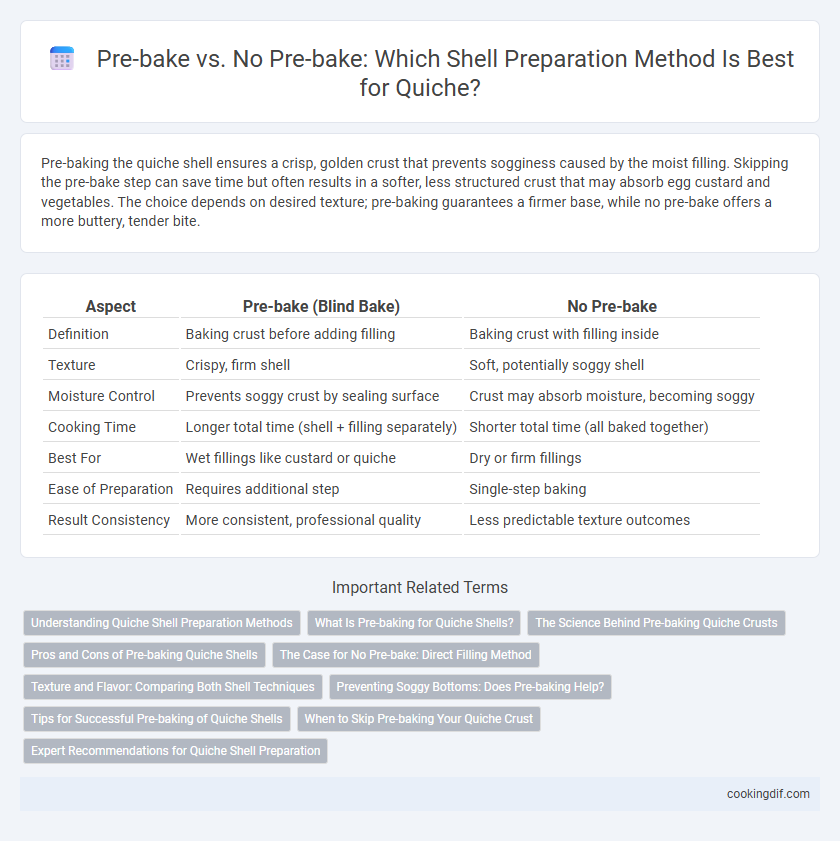Pre-baking the quiche shell ensures a crisp, golden crust that prevents sogginess caused by the moist filling. Skipping the pre-bake step can save time but often results in a softer, less structured crust that may absorb egg custard and vegetables. The choice depends on desired texture; pre-baking guarantees a firmer base, while no pre-bake offers a more buttery, tender bite.
Table of Comparison
| Aspect | Pre-bake (Blind Bake) | No Pre-bake |
|---|---|---|
| Definition | Baking crust before adding filling | Baking crust with filling inside |
| Texture | Crispy, firm shell | Soft, potentially soggy shell |
| Moisture Control | Prevents soggy crust by sealing surface | Crust may absorb moisture, becoming soggy |
| Cooking Time | Longer total time (shell + filling separately) | Shorter total time (all baked together) |
| Best For | Wet fillings like custard or quiche | Dry or firm fillings |
| Ease of Preparation | Requires additional step | Single-step baking |
| Result Consistency | More consistent, professional quality | Less predictable texture outcomes |
Understanding Quiche Shell Preparation Methods
Pre-baking the quiche shell creates a crisp, firm base that prevents sogginess by sealing the pastry before adding the custard filling. Choosing no pre-bake results in a softer, more tender crust but risks a soggy bottom due to the custard's moisture. Mastering these techniques impacts texture and structural integrity, influencing the final quiche's quality.
What Is Pre-baking for Quiche Shells?
Pre-baking for quiche shells, also known as blind baking, involves partially baking the crust before adding the filling to prevent sogginess. This technique helps maintain a crisp, golden crust by setting the dough and reducing moisture absorption from the custard filling. Pre-baking is especially crucial for quiches with high moisture ingredients, ensuring a firm and flaky texture.
The Science Behind Pre-baking Quiche Crusts
Pre-baking quiche crusts, also known as blind baking, involves partially baking the pastry before adding the filling to prevent sogginess caused by the wet custard. The science behind this technique lies in gelatinizing the starches and setting the fats in the dough, creating a moisture barrier that keeps the crust crisp during baking. Without pre-baking, the crust absorbs liquid from the filling, resulting in a soft, less structured shell that lacks the desired flaky texture.
Pros and Cons of Pre-baking Quiche Shells
Pre-baking quiche shells prevents sogginess by creating a firm barrier that keeps the filling from soaking into the crust, resulting in a crisp texture. However, this method requires extra time and attention to avoid over-baking or browning the crust unevenly. Skipping pre-baking saves time but risks a soggy bottom and less structural integrity in the final quiche.
The Case for No Pre-bake: Direct Filling Method
The no pre-bake method for quiche shell preparation preserves the crust's moisture, preventing it from becoming overly dry or crumbly. Directly filling the unbaked pastry allows the custard to bake and set simultaneously, resulting in a tender, flaky crust infused with the flavors of the filling. This technique is especially effective with high-moisture quiche fillings, as it ensures a balanced texture without the risk of an overly hard shell.
Texture and Flavor: Comparing Both Shell Techniques
Pre-baking the quiche shell creates a crisp, golden crust that prevents sogginess and enhances the buttery flavor, resulting in a more structured texture. No pre-bake shells tend to absorb moisture from the filling, leading to a softer, sometimes slightly doughy base with a more subtle flavor. Texture and flavor differences significantly influence the overall quiche experience, with pre-baking favored for a firmer, more pronounced crust and no pre-bake preferred for a tender, softer bite.
Preventing Soggy Bottoms: Does Pre-baking Help?
Pre-baking the quiche shell creates a barrier that prevents the custard filling from soaking into the crust, effectively reducing sogginess. Blind baking with pie weights ensures even cooking and crispiness, essential for a firm, non-mushy bottom. Conversely, no pre-bake often results in a soggy base as the raw pastry absorbs moisture from the filling during baking.
Tips for Successful Pre-baking of Quiche Shells
Pre-baking quiche shells requires docking the dough with a fork to prevent bubbling and using pie weights or dried beans to ensure the crust maintains its shape during baking. Chill the crust for at least 30 minutes before pre-baking to reduce shrinkage and promote even cooking. Bake the shell at 375degF (190degC) until the edges are golden and the center appears slightly set, typically 15-20 minutes.
When to Skip Pre-baking Your Quiche Crust
Skipping pre-baking your quiche crust is ideal when using a very tender dough or when the filling is high in moisture, as excessive baking can cause a dry or overly crispy crust. Custard-based fillings with sufficient firmness after baking, like those containing eggs and cream, help the crust set properly without pre-baking. Avoid skipping pre-baking if the recipe calls for a single crust with less moist fillings, as this can lead to a soggy bottom.
Expert Recommendations for Quiche Shell Preparation
Expert chefs recommend pre-baking the quiche shell to prevent sogginess by creating a barrier that keeps the custard filling from seeping into the crust. Pre-baking, also known as blind baking, ensures a crisp, golden shell, especially important when using moist fillings like vegetables or cheese. Skipping the pre-bake can result in a softer crust, which may be acceptable for high-fat fillings but generally compromises the classic flaky texture of a perfect quiche.
Pre-bake vs No Pre-bake for Shell Preparation Infographic

 cookingdif.com
cookingdif.com